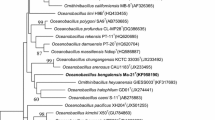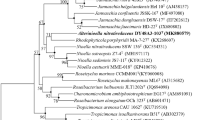Abstract
A new chemolithotrophic nitrite-oxidizing bacterium, for which the name Nitrospira marina is proposed, was isolated from the Gulf of Maine. N. marina is a Gramnegative curved rod which may form spirals with 1 to 12 turns. Cells have a unique periplasmic space and lack intracytoplasmic membranes and carboxysomes. N. marina is an obligate chemolithotroph, but best growth is obtained in a mixotrophic medium. N. marina may be one of the most prevalent nitrite-oxidizing bacteria in some oceanic environments. Type strain is field with American Type Culture Collection (ATCC 43039).
Similar content being viewed by others
References
Barnes H (1959) Apparatus and methods of oceanography. George Allen & Unwin Ltd, London, pp 117–118
Bendschneider K, Robinson RJ (1952) A new spectrophotometric method for the determination of nitrite in sea water. J Mar Res 11:87–96
Bradford MM (1976) Rapid and sensitive method for the quantitation of microgram quantities of protein utilizing the principles of protein-dye binding. Ann Biochem 72:248–254
De Ley J (1970) Reexamination of the association between melting point, buoyant density, and chemical base composition of deoxyribonucleic acid. J Bacteriol 101:738–754
Heubült J (1929) Untersuchungen über Nitritbakterien. Planta 8:398–422
Kraft I, Bock E (1984) Plasmids in Nitrobacter. Arch Microbiol 140:79–82
Marmur Y (1961) A procedure for the isolation of desoxyribonucleic acid from microorganisms. J Mol Biol 3:208–218
Milde K, Bock E (1984) Isolation and partial characterization of inner and outer membrane fractions of Nitrobacter hamburgensis. FEMS Microbiol Lett 21:137–141
Murray RGE, Watson SW (1965) Structure of Nitrosocystis oceanus and comparison with Nitrosomonas and Nitrobacter. J Bacteriol 89:1594–1609
Spector T (1978) Refinement of the coomassie blue method of protein quantitation. Ann Biochem 86:142–146
Sundermeyer-Klinger H, Meyer W, Warninghoff B, Bock E (1984) Membrane-bound nitrite oxidoreductase of Nitrobacter: evidence for a nitrate reductase system. Arch Microbiol 140:153–158
Watson SW (1965) Characteristics of marine nitrifying bacterium, Nitrosocystis oceanus sp. n. Limnol Oceanogr (Suppl) 19: R274-R289
Watson SW (1971) Reisolation of Nitrosospira briensis S. Winogradsky and H. Winogradsky 1933. Arch Microbiol 75:179–188
Watson SW (1974) Family I. Nitrobacteraceae. In: Buchanan RE, Gibbons NE (ed) Bergey's manual of determinative bacteriology, 8th ed. The Williams & Wilkins Co, Baltimore, pp 450–456
Watson SW, Graham LB, Remsen CC, Valois FW (1971) A lobular, ammonia-oxidizing bacterium: Nitrosolobus multiformis nov. gen. nov. sp. Arch Mikrobiol 76:183–203
Watson SW, Waterbury, JB (1971) Characteristics of two marine nitrite oxidizing bacteria, Nitrospina gracilis nov. gen. nov. sp. and Nitrococcus mobilis nov. gen. nov. sp. Arch Mikrobiol 77:203–230.
Winogradsky S (1892) Contribution à la morphologie des organismes de la nitrification. Arch Sci Biol (St Petersb) 1:86–137
Author information
Authors and Affiliations
Rights and permissions
About this article
Cite this article
Watson, S.W., Bock, E., Valois, F.W. et al. Nitrospira marina gen. nov. sp. nov.: a chemolithotrophic nitrite-oxidizing bacterium. Arch. Microbiol. 144, 1–7 (1986). https://doi.org/10.1007/BF00454947
Received:
Accepted:
Issue Date:
DOI: https://doi.org/10.1007/BF00454947




